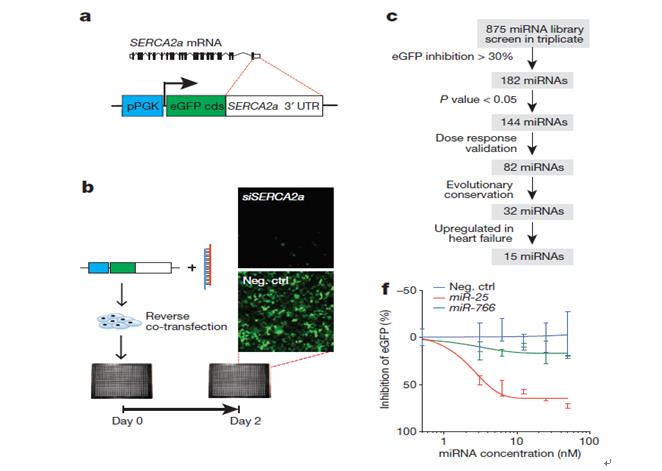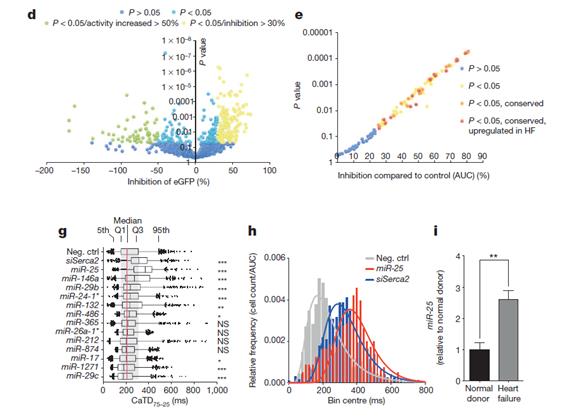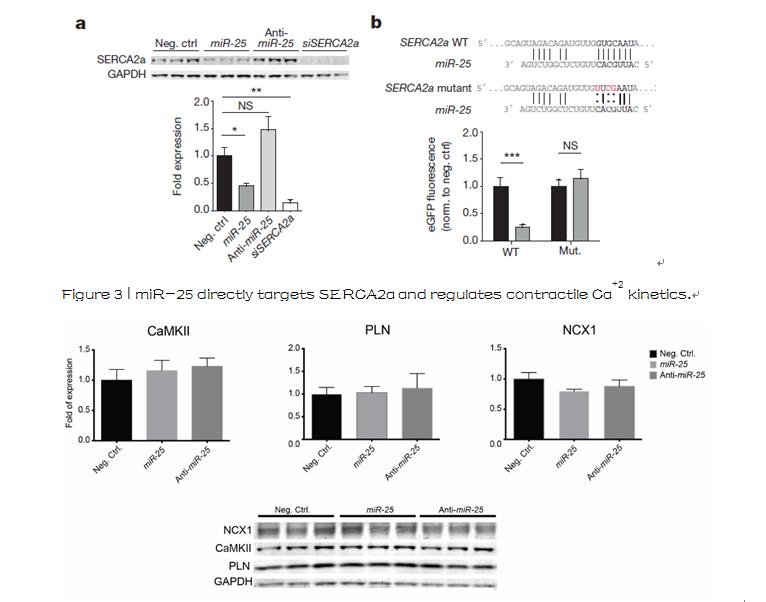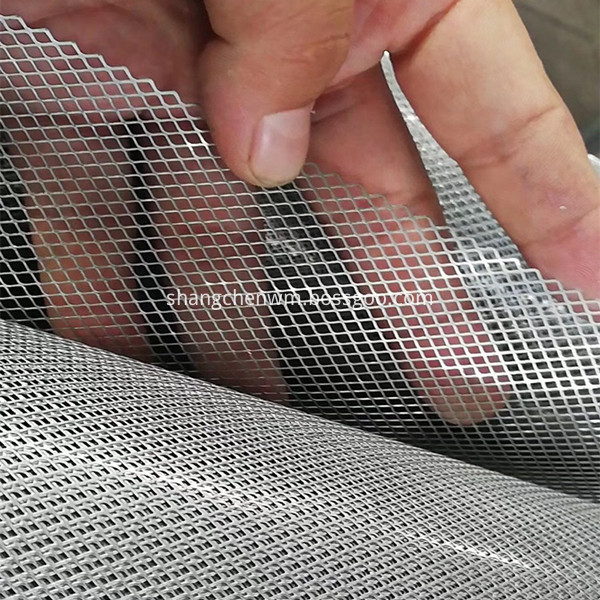Vala KIC real-time ultra-fast high-content cell analyzer for assisting heart failure targeting miRNA screening and mechanism research
Heart failure is the peak of various cardiovascular diseases, including hypertension, ischemic disease and atherosclerosis, valvular insufficiency, myocarditis and contractile protein mutations and gradual loss of contractile function. A common therapeutic strategy is to block the deleterious effects of renin-angiotensin and the sympathetic nervous system, but current drugs are rarely targeted to the mechanism of failing cardiomyocytes, so there is an urgent need to develop new drugs, especially for the treatment of patients. Drugs for advanced heart failure. Complex intracellular networks can balance contractile forces and intracellular Ca 2+ processing associated with work review; however, the role of miRNAs in cardiac contractility remains largely undeveloped, and miRNAs can be fine-tuned for almost all normal and pathological processes. And by down-regulating the protein biocontrol network that occupies key nodes. Therefore, we speculate that miRNA's ability to inhibit contraction is up-regulated in heart failure and may be used as a new target for therapeutic intervention.
The calcium transporter ATPase SERCA2a is the primary mechanism of calcium uptake. During the excitatory-contraction coupling process of cardiomyocytes, the decrease of SERCA2a expression and the decrease of activity lead to calcium uptake injury, which is an important marker of heart failure. Restoration of the corresponding SERCA2a by gene transfection has been proven to be effective in improving animal models and clinical trials. Key parameters of heart failure, therefore, miRNAs down-regulate SRCA2a, heart failure may increase, and cardiac function may be impaired.

In order to find miRNAs for heart failure, teachers at Stanford University's Birmingham Medical School and the University of California found that more than 300 miRNAs targeting SERCA2a were predicted by computer algorithms. The results were error-prone and required empirical evaluation, so the KIC of Vala was high. connotation ultrahigh imaging speed, cells were identified by analysis of high-throughput analysis of single hole technology, the whole genome can be down-regulated miRNA calcium ion pumps did screening assays, while screening the effects of calcium miRNA do real-time tracking analysis, Finally, miR-25 was found to cause heart failure by down-regulating SRCA2a. Inhibition of miR-25 can improve cardiac systolic function and repair heart failure, and the result is published in Nature's letter "Inhibition of miR-25 improves cardiac contractility in the failing heart".
experiment
The whole miRNA library of the whole genome was selectively screened down by the Vala KIC ultra-high-speed high-content cell analysis system. The downstream of the 3' non-coding region of ERCA2a mRNA 39 was fused with the enhanced green fluorescent coding region to construct a an active sensor for detecting miRNA targeted by the low signal of eGFP (Fig. 1a, b), through KIC Vala's high content analysis systems and ultra high imaging speed by one to each well and the statistical analysis function of cells were screened The results showed that 144 miRNAs reduced fluorescence by 30%, P < 0.05 (Fig. 1c, d), and 82 miRNAs were confirmed by dose testing (Fig. 1e, f and Supplementary Table 1). 32 were evolutions. Conservative, 15 evolutionarily conserved and up-regulated in heart failure, 4 one-tailed variance prolonged in HL-1 cardiomyocytes leading to significant calcium transient attenuation, showing a maximum duration from 75% to 25% (CAD 75-25) ), and found that the most potent miRNA is miR-25, its relative siRNA directly targets SERCA2a, siSERCA2a, miR-25 elicited significant physiological effects, and confirmed that miR-25 is up-regulated in patients with heart failure, Hybridization show miR-25 expression in primary aortic constriction induced heart failure cardiomyocytes, myocardial fibers or not expressed in hemangiopericytoma, no expression in vascular smooth muscle cells (Fig. 2).


Figure 1 | High-content screening identifies miRNAs that control SERCA2a. a, b

Figure 2 | Endogenous miR-25 expression in the heart
To establish a link between miR25 and cardiac function, we identified a Ca 2+ treatment-associated protein that was inferred by calculations. The proteins screened in HL-1 cells, in addition to SERCA2a, also include IP3R1, which is selected by transient miR-25. Downregulation, and other calcium-treated proteins that are unaffected after transfection with miR-25, including soda-calcium exchangers (NCX1, also known as SLC8A1), calmodulin kinase 2 (CaMKII), phosphoprotein (PLN), and calcium 3 (CALM3), (Extended Data Fig. 2), miRNA binds to homologous mRNA through specific elements of inexact base pairing. The single putative miR25 recognition region was between the SECA2A and IP3R1 39 UTR sequences by TargetScanHuman v.6.2 analysis. These mutated sequences abolish the inhibition of reporter expression by miR25, which further supports the interaction of the selected miR25 with mRNA and suggests that the recognition elements of the 3'UTRS end of the identified SERCA2a and IP3R1 mRNA are sufficient for miR-25 active. 
Extended Data Figure 2 | Effect of miR-25 on calcium handling proteins
It has been shown that miR-25 can regulate SERCA2a and IP3R1, and then use Vala's KIC high-content analysis system to record cells for 72 hours, at 1 Hz, plus 5ms of 15V electrical pulse, and start recording at 2 seconds. Calcium flow was performed on individual cells in each well at 33 fps. It was tested whether siRNA directly interacted with these proteins to mimic the effect of miR-25 on calcium transient kinetics in the body; results were found in neonatal rats. In ventricular cardiomyocytes and HL-1 cells, SERCA2a transfection significantly reduced the transient (Ca TD 75–25) decay phase (Ca 2+ reabsorption), whereas the maximum upward rate of Ca 2+ transient was not affected. The effect, which accurately reproduces the effects of miR-25, mimics a 1.5-2 fold decrease in attenuation in ventricular myocytes isolated from a depleted human heart. In HL-1 cells, anti-IP3R1 siRNA had little effect on Ca 2+ transient kinetics, but had no effect on NRVCS (CAD50, CAD75-25 and Vmax), indicating the transient kinetics of miR-25 on Ca 2+ . The regulation is mainly achieved by down-regulating the expression of SRCA2a. Vala KIC has high- intelligence and accurate data analysis, scientifically and accurately describes the mechanism of miR-25 in myocardial contraction, and finds a target for the treatment of heart failure.

Extended Data Figure 1 | Effect of miR-25 on IP3R1 and cardiomyocyte calcium transients in vitro
For more details, please read the full article: https://
And can contact us for a full article

Vala KIC's real-time ultra-high-speed, high-content cell analysis system 's outstanding advantages in miRNA screening and calcium flow research:
★ Ultra-high imaging speed: 0.1-1500Hze, suitable for calcium flow and action potential detection
★Automatic stimulation options: electrical stimulation, optogenetics, liquid handling
★Double focus imaging: surface tracking + image focusing to ensure clear image of each cell
★High throughput: 96/384-well high-throughput analysis, the fastest 1-2min/96 holes
★ Standard 4 fluorescent channel and dual objective lens, channel and objective lens can be expanded
Expanded Metal
Expanded metal also named diamond metal mesh, that uses the high quality low carbon steel plate, aluminium plate, stainless steel plate, galvanized steel plate, nickel plate, titanium plate, lead plate and so on be punched to mesh. Expanded metal mesh including: standard expanded metal, flattened expanded metal, architectural expanded metal, micro expanded metal, ribbon expanded metal, custom fabricated expanded metal.
The surface treatment of expanded metal sheet: PVC coated, galvanized, anodizing, antirust painted
The material: high quality low carbon steel plate, aluminium plate, stainless steel plate, galvanized steel plate, nickel plate, titanium plate, lead plate
The uses of expanded metal panel: Filter Mesh, Filter Cartridge, platforms, catwalks, walkways, decorative building, rail enclosures, conveyors, etc
The advantages of expanded metal:
beautiful, strong and durable
uniform mesh, smooth surface, high friction coefficient and strength
easy cutting and process
The mesh is firm
shockproof
resistant to high temperature
no deformation, no rust
non-toxic and tasteless
easy to use

Expanded Copper Mesh,Copper Expanded Mesh,Decorative Expanded Mesh,Stainless Steel Expanded Metal
ANPING COUNTY SHANGCHEN WIREMESH PRODUCTS CO.,LTD , https://www.scwpwiremesh.com